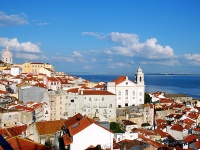 Lisbon OverviewThe capital of Portugal has experienced a renaissance in recent
years and has reclaimed its rightful place as the 'golden city' of
southern Europe. After slumbering for decades, the city's modern,
vibrant and cosmopolitan identity is today much similar to that
which it enjoyed in the 15th and 16th centuries during the age of
the great discoverers, when Lisbon was the centre of trade with the
East and the starting point for maritime exploration of the
globe. The city fathers of Lisbon elected to invest in some
rejuvenation in the 1990s, and this ongoing focus on the future has
made the most of the city's attributes and attractions, both old
and new. Infrastructure has also been improved, with additions like
the impressive Vasco da Gama Bridge across the River Tagus, which
links the city's airport to a network of national motorways and has
facilitated access to other parts of Portugal. There is also a new
showcase railway hub, the Gare de Oriente, which is the pride of a
new modern suburb on the east bank of the Tagus, creating an even
better link between Lisbon and the rest of Europe. While much is new, there is plenty of the old left to charm
visitors, giving the metropolis a slightly provincial air. The
delightful, picturesque medieval section of Alfama skirts the
city's Sao Jorge castle, and historic wooden trams ply noisily up
and down steep hills past art deco cafes and mosaic-decorated
pavements. Many of the relics of the city's golden age were
destroyed in an earthquake in 1755, but some survived and are
popular tourist attractions, complemented now by modern sights,
like the futuristic Oceanarium. Within easy reach of the city are the sandy beaches of several
coastal resorts, such as Costa da Caparica, Estoril and Cascais, as
well as the forested areas of Sintra and attractions like the
extraordinary Mafra monastery. The mood of Lisbon is light and
bright, confident, fresh and avante garde, ready to welcome the
world to the doorstep as one of the great capitals of Europe. |